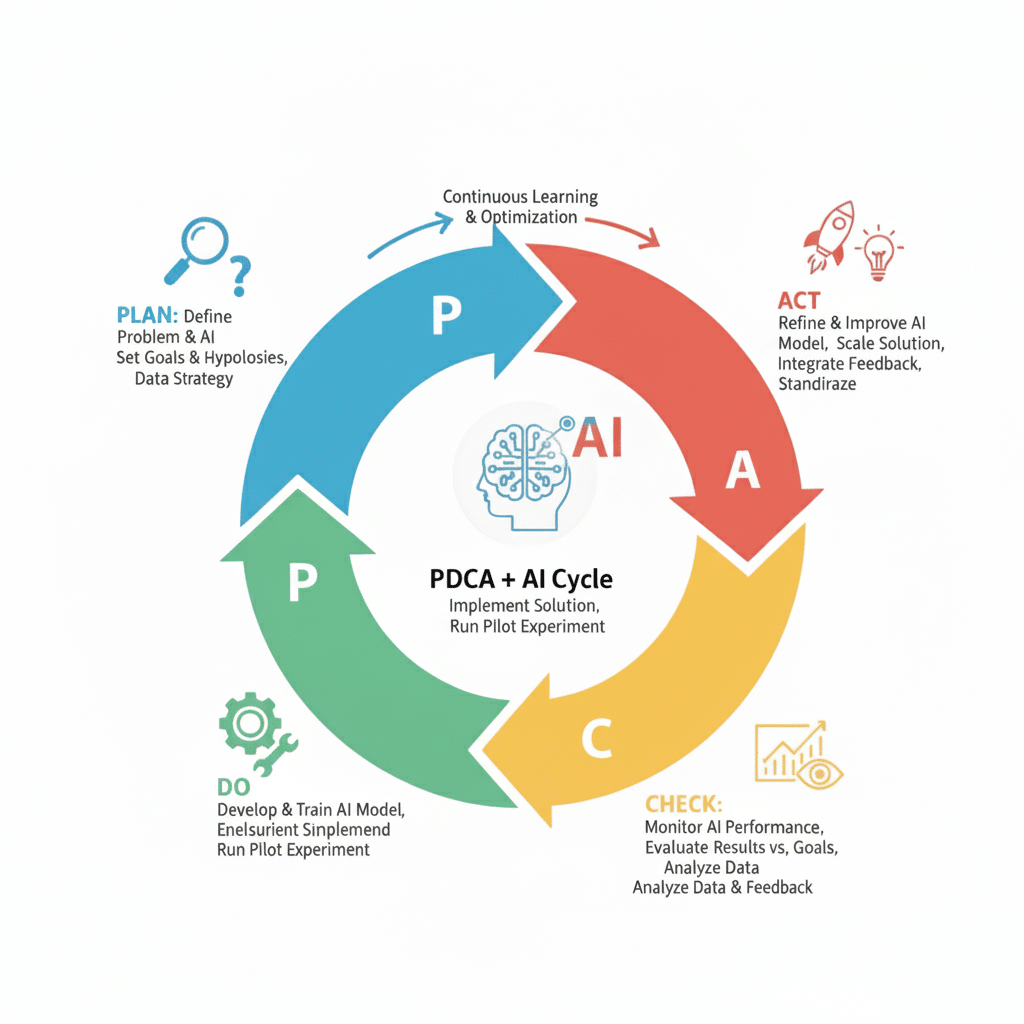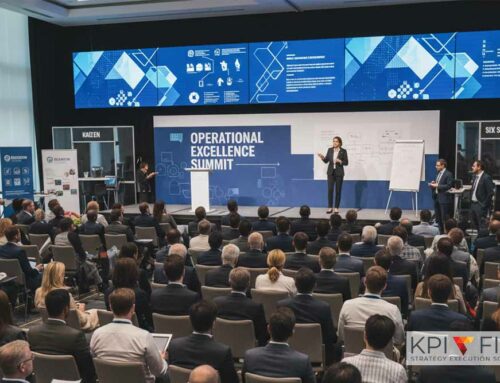How can your company move past the hype and execute successful AI projects that deliver real business value? This article reveals the practical solution: leveraging the PDCA cycle to provide structure and rigor to inherently uncertain AI initiatives. Learn how this continuous improvement framework transforms AI experimentation into a measurable, repeatable business process, and discover how KPI Fire serves as the ideal platform to plan, track, and measure your AI initiatives across the full PDCA cycle.
The Hype vs. the Hard Work of AI
Every company today feels the pressure to “do something with AI.” But in the rush to deploy chatbots, predictive models, or automation, many leaders overlook a crucial question:
“What problem are we actually trying to solve — and how will we know if it worked?”
Without a clear, structured approach, AI projects can quickly become science experiments that drain time, money, and credibility.
That’s where structured problem solving — and specifically, the PDCA (Plan-Do-Check-Act) cycle — becomes your best ally. It gives you a framework for experimentation, data-driven learning, and justification for investment — all while reducing risk.
A Quick Refresher: What Is PDCA?
PDCA is a continuous improvement cycle originally popularized by Dr. W. Edwards Deming. It’s a simple yet powerful loop that ensures every initiative — from a Lean project to an AI deployment — is grounded in learning and measurable results.
-
Plan: Define the problem, gather data, and set measurable objectives.
-
Do: Implement a small-scale test or pilot.
-
Check: Evaluate the results against your plan.
-
Act: Standardize success or adjust based on what you’ve learned.
Each loop becomes a mini-experiment — a disciplined way to explore new ideas, verify assumptions, and scale what works.
Why AI Needs PDCA More Than Ever
AI projects are inherently uncertain. They involve data quality issues, shifting objectives, technical unknowns, and stakeholder skepticism. PDCA brings structure to that uncertainty:
| Common AI Challenge | How PDCA Helps |
|---|---|
| Unclear goals or business case | Plan forces you to define the problem, KPIs, and success metrics upfront. |
| Data gaps and integration issues | Do uncovers data challenges early in a pilot setting. |
| Model underperformance | Check provides a structured review of accuracy, bias, and ROI. |
| Governance & ethics | Act embeds lessons learned and guardrails before scaling. |
| Leadership skepticism | PDCA creates a clear, evidence-based story for continued investment. |
In other words, PDCA turns “AI experimentation” into continuous improvement — a measurable, repeatable business process rather than a gamble.
Example: Applying PDCA to an AI Initiative
Let’s say your operations team wants to use AI for predictive maintenance — reducing equipment downtime using sensor data.
🧩 Plan
-
Define the problem: unplanned downtime costs $250,000 per year.
-
Hypothesis: a predictive model can reduce downtime by 20%.
-
Scope: one machine line for a 90-day pilot.
-
Metrics: downtime %, false-alert rate, maintenance cost reduction.
-
Risks: incomplete sensor data, IT integration barriers, model bias.
⚙️ Do
-
Build and test a pilot model using historical sensor data.
-
Deploy alerts in a limited environment.
-
Train maintenance staff on how to interpret predictions.
-
Document every anomaly and failure mode.
📊 Check
-
Compare actual downtime to the baseline.
-
Validate model accuracy and usefulness.
-
Gather qualitative feedback from maintenance teams.
-
Assess ROI and adoption readiness.
🚀 Act
-
If the pilot meets targets, expand to additional lines.
-
Standardize data collection and response workflows.
-
If results fall short, adjust inputs, model parameters, or scope — and begin a new PDCA cycle.
Each iteration sharpens your model, your data, and your organizational readiness.

How PDCA Strengthens the Business Case for AI
Here’s how PDCA helps leaders justify and sustain AI investment:
-
Lower Risk Through Iteration
You’re not betting big on unproven technology; you’re learning in small, measurable loops. -
Data-Driven Decision Making
Each cycle generates evidence to support — or challenge — further investment. -
Organizational Learning
The “Check” and “Act” steps capture lessons that improve not only the model but also team processes. -
Governance and Accountability
Documentation through PDCA aligns with audit, compliance, and ethics standards. -
Scalable Success
Once an AI use case proves its value, it can be replicated across teams or regions with confidence.
Practical Tips for Using PDCA in AI Projects
-
Start small — one pilot, one measurable outcome.
-
Involve both technical and business teams in the Plan phase.
-
Define baseline metrics before you start.
-
Build dashboards to track your Check stage in real time (KPI Fire helps with this).
-
Celebrate learning, not just success — a “failed” cycle that reveals why is still progress.
-
Always close the loop: document what was learned and standardize what worked.
PDCA + AI = Continuous Improvement at Digital Speed
Artificial Intelligence can amplify human decision-making — but only when guided by structured problem solving. PDCA turns AI into a continuous improvement engine: learning, adapting, and evolving in sync with your organization. At KPI Fire, we believe that Continuous Improvement IS the Strategy — and AI, managed through PDCA, is simply the next evolution of that strategy.
✅ Ready to Start?
Use KPI Fire to plan, track, and measure your AI initiatives — from pilot tests to enterprise rollout — in one visual platform that supports the full PDCA cycle.
👉 Schedule a Demo
👉 Learn More About Strategy Execution Software




